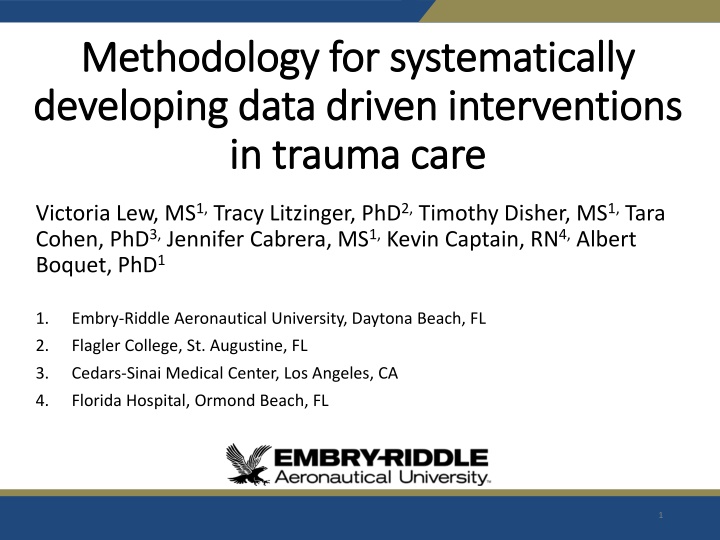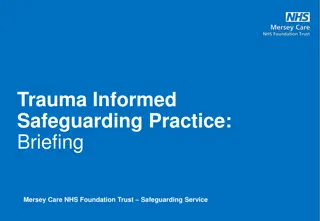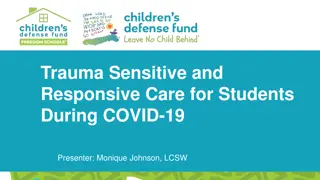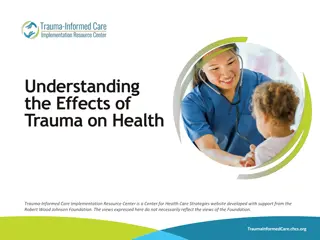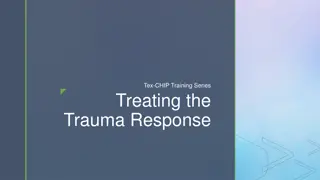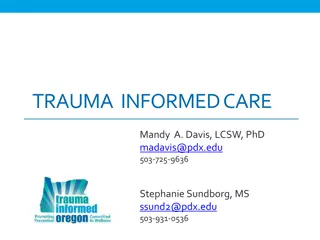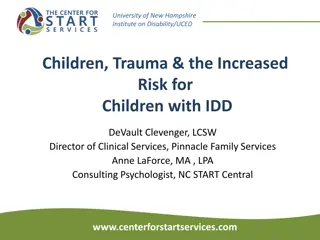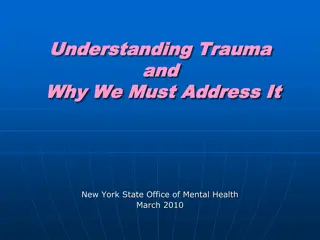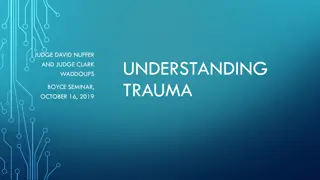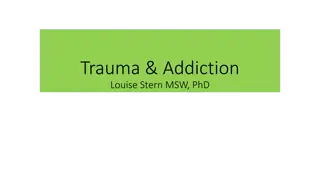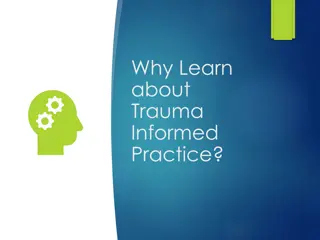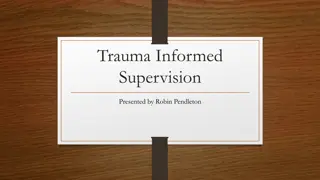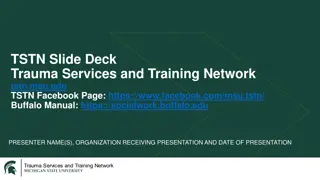Developing Data-Driven Interventions in Trauma Care
The study focuses on systematically developing data-driven interventions in trauma care at a Level II trauma center to reduce targeted flow disruptions. Pre-intervention data collection involved observing and recording flow disruptions in trauma cases, which were classified using the RIPCHORD-TWA taxonomy for analysis.
Uploaded on Mar 16, 2025 | 2 Views
Download Presentation

Please find below an Image/Link to download the presentation.
The content on the website is provided AS IS for your information and personal use only. It may not be sold, licensed, or shared on other websites without obtaining consent from the author.If you encounter any issues during the download, it is possible that the publisher has removed the file from their server.
You are allowed to download the files provided on this website for personal or commercial use, subject to the condition that they are used lawfully. All files are the property of their respective owners.
The content on the website is provided AS IS for your information and personal use only. It may not be sold, licensed, or shared on other websites without obtaining consent from the author.
E N D
Presentation Transcript
Methodology for systematically Methodology for systematically developing data driven interventions developing data driven interventions in trauma care in trauma care Victoria Lew, MS1,Tracy Litzinger, PhD2,Timothy Disher, MS1,Tara Cohen, PhD3,Jennifer Cabrera, MS1,Kevin Captain, RN4,Albert Boquet, PhD1 1. Embry-Riddle Aeronautical University, Daytona Beach, FL 2. Flagler College, St. Augustine, FL 3. Cedars-Sinai Medical Center, Los Angeles, CA 4. Florida Hospital, Ormond Beach, FL 1
Background: The current state of healthcare training Focus on technical skills rather than the essential soft skills Teamwork Communication Problem Solving Generic in nature Not tailored to specific institutions/disciplines 2
Background: The desired state of healthcare training Quantitative, data-driven process to identify weaknesses Proactive approach using identified flow disruptions (FDs) FDs: deviations from the natural progression of a task that potentially compromise the safety of the process and/or task (Wiegmann et al., 2007) Develop training programs that target inefficiencies prior to occurrence of an error 3
Goal of the current study Environment Level II trauma center Trauma Among the top five leading causes of death in the US (CDC, 2015) The leading cause of death for individuals birth to age 46 (Rhee et al., 2014) Goal Demonstrate the development of a data-driven training program Aimed at reducing targeted FDs 4
Method Pre-intervention data collection Data acquisition 65 complete trauma cases Patient arrival in trauma bay (resuscitation) to imaging Observers: trained medical HF researchers Observed/recorded FDs Data Analysis FDs classified into the HF taxonomy RIPCHORD-TWA (Cohen et al., 2016) Consensus coding 5
RIPCHORD-TWA Taxonomy Communication (verbal and non-verbal) Ineffective Communication Lack of Response Confusion Simultaneous Communication Nonessential Communication Environmental Noise Lack of Sharing Coordination Personnel Rotation Personnel Not Available Unknown Information Protocol Failure Charting/Documentation Planning/Preparation Usability Computer Design Equipment Design Surface Design Barrier Design Packaging Design Data Entry (non-computer) Design Interruptions (other) Distractions Teaching Moments Searching Activity Task Deviation Alerts Equipment/Supplies Spilling/Dropping Interaction with Biohazards Layout Connector Positioning Equipment Positioning Furniture Positioning Permanent Structures Positioning Inadequate Space Wires/Tubing Equipment Issues Surgeon Equipment Anesthesia Equipment Perfusion Equipment General Equipment 6
Results Pre-intervention data 65 cases observed; 1,137 FDs identified 2,468 patient contact minutes (average=38 min/case, s=17.6 min) 17.5 disruptions per case (average) Ratio=0.46 FDs/min (1 disruption every 2 minutes) 60% 50% 40% 30% 20% 10% 0% Communication Coordination Equipment Issues Interruptions Layout Usability RIPCHORD-TWA Major Categories 7
Results Pre-intervention data: Communication 60% 50% 40% 30% 20% 10% 0% Ineffective Communication Lack of Response Confusion Simultaneous Communication Nonessential Communication Environmental Noise Lack of Sharing RIPCHORD-TWA Communication Minor Categories 8
Results Pre-intervention data: Interruptions 60% 50% 40% 30% 20% 10% 0% Distractions Teaching Moments Searching Activities Task Deviation Alerts Equipment/Supplies Spilling/Dropping RIPCHORD-TWA Interruptions Minor Categories 9
Results Pre-intervention data: Coordination 60% 50% 40% 30% 20% 10% 0% Personnel Not Available Unknown Information Protocol Failure Charting/Documentation Planning/Preparation RIPCHORD-TWA Coordination Minor Categories 10
Development of Interventions Focus on four areas of weakness for intervention development Nonessential communication Ineffective communication Distractions Planning/preparation 11
Development of Interventions Human Factors Intervention Matrix (HFIX) Multidisciplinary Knowledge Elicitation Exercise (MKE) (Shappell & Wiegmann, 2006) Brainstorm intervention strategies to each of the four areas using HFIX Event: 2 hours with 19 SMEs 4 Trauma Surgeons 7 ED RNs 4 ED Techs 3 Administrative Personnel 1 Chaplain performance? Problem Environment Task Technology Individual/ Team Supervisory/ Organizational The issue identified How can the physical environment be modified or redesigned to reduce risk or improve How can the task or activity be modified or redesigned to reduce risk or improve performance? How can the tools, equipment or technology be modified or redesigned to reduce risk or improve performance? How can aspects of the individual or team be modified or changed to reduce risk or improve performance? How can supervisory or organizational factors be modified or to reduce risk or improve performance? 12
Development of Interventions 97 interventions generated during brainstorming Ranked each intervention using FACES (on 5 point Likert scale) Feasibility Acceptability Cost/Benefit Effectiveness Sustainability Result 34 possible interventions 13
Development of Interventions Thematic analysis to reduce interventions 19 of the 34 could be clustered into 4 themes Formal leadership/team training Role identification Pre-arrival checklist/brief/debrief Standardized communication protocols 14
Intervention: Formal leadership and team training program (TCTP) Participants ED nurses (many serve role as trauma nurse) Compensated with non-productive pay and CEUs Process Mandatory Lead by trauma services manager and HF researchers Training Curriculum Leadership Teamwork Communication 15
Intervention: Formal leadership and team training program (TCTP) Leadership (Denhardt et al., 2013; Sakran, 2011; Tye, n.d.) Qualities of a leader How to be an effective leader How the roles of both leader and follower can impact the team Teamwork (Salas et al., 2009; Tannenbaum & Cerasoli, 2013; Weaver et al., 2010) ABCs of teamwork Roles, responsibilities, and expectations of team members Role identification sticker system Brief/debrief Communication Call outs, closed-loop communication, and read backs Scenarios to practice 16
Intervention: Formal leadership and team training program (TCTP) Training evaluation questionnaire 4 questions 5 point Likert scale (strongly agree to strongly disagree) Questions 1) Did the course meet the stated objectives? 2) Was the course information appropriate? 3) Was the educational level appropriate? 4) Was the teaching method appropriate Results strongly agree on all 4 questions by 95% respondents 17
Intervention: Formal leadership and team training program (TCTP) Content related test (pre- and post- training program) Pre-test: average score = 74% (s= 10.39) Post-test: average score =94% (s= 6.98) t (65) = -13.92, p .01 18
Discussion/Limitations Discussion First demonstration of a systematic, data-driven training program This process can help healthcare organizations to: Measure personalized inefficiencies Deploy interventions to target systemic vulnerabilities Limitations Mandatory Attendance Environment (organizational apathy/non-compliance) 19
References Centers for Disease Control and Prevention (CDC). (2015). Guidelines for field triage of injured patients: Recommendations of the national expert panel on field triage. MMWR, 61(1), 1-20. Atlanta, GA: Division of Injury Response, National Center for Injury Prevention and Control, CDC. Cohen, T.N. Cabrera,J.S., Pohl, E.E., Sisk, O.D., Welsh, K.W., Abernathy, J.H., Reeves, S.T., Wiegmann, D.A., Shappell, S.A., & Boquet, A.J. (2016). Identifying workflow disruptions in the cardiovascular operating room. Anesthesia, 71(8), 948-954. Denhardt, R. B., Denhardt, J. V., & Aristigueta, M. P. (2013). Managing human behavior in public and nonprofit organizations. Los Angeles: Sage Publications. Rhee, P., Joseph, B., Pandit, V., Aziz, H., Vercruysse, G., Kulvatunyou, N., & Friese, R.S. (2014 July). Increasing trauma deaths in the United States. Annals of Surgery, 260 (1), 13-21. Sakran, J. V., Finneman, B., Maxwell, C., Sonnad, S. S., Sarani, B., Pascual, J., Kim, P., Schwab, C. W., & Sims, C. (2012). Trauma leadership: Does perception drive reality? Journal of Surgical Education, 69(2), 236-240.Salas, E., Diaz Granados, D., Klein, C., Burke, C. S., Stagl, K. C., Goodwin, G. F., & Halpin, S. M. (2008). Does team training improve team performance? A meta-analysis. Human Factors, 50(6), 903-933. Salas, E., Rosen, M. A., Burke, C. S., & Goodwin, G. F. (2009). The wisdom of collectives in organizations: An update of the teamwork competencies. In E. Salas, G. F. Goodwin, & C. S. Burke (Eds.), Team Effectiveness in Complex Organizations. Cross Disciplinary Perspectives and Approaches (pp. 39- 79). New York: Psychology Press. Shappell, S. & Weigmann, D. (2006). Developing a Methodology for Assessing Safety Programs Targeting Human Error in Aviation. Report number: DOT/FAA/AM-06/24. Washington, D.C.: Office of Aerospace Medicine/Federal Aviation Administration. Tannenbaum, S.I., & Cerasoli, C.P. (2013). Do team and individual debriefs enhance performance? A meta-analysi. Human Factors, 55(1), 231- 245. Tye, J. (n.d.). The twelve core action values: Workbook for the values coach guided self-coaching course. Solon, IA: Values Coach America. Weaver, S.J., Rosen, M.A., Salas, E., Baum, K.D., & King, H.B. (2010). Integrating the science of team training: guidelines for continuing education. Journal of continuing education in the health professions, 30(4), 208-220. Wiegmann, D.A., ElBardissi, A.W., Dearani, J.A., Daly, R.C., & Sundt, T.M. (2007). Disruptions in surgical flow and their relationship to surgical errors: An exploratory investigation. Surgery, 142, 658-665. 20
Thank you! Questions? Victoria K. Lew, MS Doctoral Candidate, Embry-Riddle Aeronautical University lewv@my.erau.edu Albert J. Boquet, PhD Professor, Embry-Riddle Aeronautical University boque007@erau.edu 21
